Birds see more colors than we do, thanks to their four color receptors. This means using color is key to getting birds in your backyard. They use colors to find mates and avoid danger, too.
Having a garden that’s colorful and bird-friendly is all about knowing which colors attract different birds. For instance, hummingbirds love bright red flowers while bluebirds and jays are into the color blue. So, the right colors can bring you a variety of bird species.
Key Takeaways
- Birds perceive a wider range of colors than humans, making color a crucial factor in attracting them to your backyard.
- Different bird species are drawn to specific hues, with colors often signaling the presence of food or acting as mating signals.
- Strategically using color can help create a vibrant, bird-friendly garden that caters to a diverse array of feathered visitors.
- Hummingbirds are attracted to vibrant red colors, while bluebirds and jays are drawn to blue hues.
- Positioning brightly colored elements in sunlight can enhance their visibility and appeal to birds.
Understanding the Significance of Color in Attracting Birds
Birds see colors differently than we do because they have more color receptors. Where humans see three colors, birds see four, which includes ultraviolet light. Their special vision helps them with important tasks like choosing mates and finding food safely. This is why knowing about bird color vision is key to attracting them to our spaces.
How Birds Perceive Color Differently from Humans
Compared to humans, birds have an extra photoreceptor. This helps them see a wider variety of colors, even those in ultraviolet light. Bird eyes are more sensitive to colors, allowing them to notice small changes that we can’t see. So, they experience a more detailed and vibrant color world than we do.
The Role of Color in Bird Behavior and Survival
- Color is crucial for birds, guiding their choices in selecting mates, defending their territory, and interacting with others.
- Male birds with bright colors attract females, while females use duller shades to hide when taking care of their young.
- Bird vision spectrum helps them spot predators and food that are hard for us to see, boosting their survival odds.
- Colors like blue, purple, and green are typically bird favorites as they signal abundant energy, unlike red and yellow, which can warn them of danger.
Knowing how birds see color lets us design our spaces in ways that appeal to them. By using colors wisely, we can make our areas more inviting to a variety of bird species.
Colors That Attract Hummingbirds
Hummingbirds love red. They are attracted to it because it often signals nectar-rich flowers. By adding red flowers like wild columbine and royal catchfly to your garden, you invite them in.
But it’s not just red that hummingbirds like. They enjoy other colors too, such as pinks, blues, purples, and greens. Planting a mix of colorful, nectar-filled blooms can make your garden a paradise for them. Native plants like bee balm and cardinal flower are perfect choices for this.
Using colorful feeders can also attract hummingbirds. Even though the nectar inside is their main interest, red feeders catch their eye. Studies show they are drawn to red and yellow, enhancing their appeal.
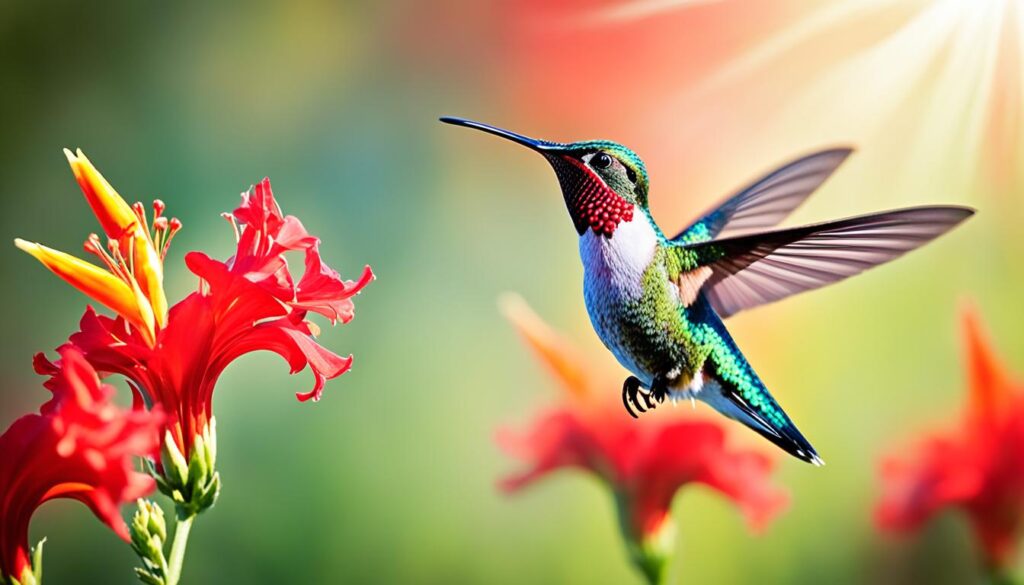
Creating a space that hums will also include special features. Adding moving water like misters or small fountains offers these birds a place to bathe and drink. This can encourage more visits to your garden.
By being smart about color and adding the right plants, feeders, and water, you can welcome hummingbirds. Your space will not only look beautiful but also be a place where these amazing birds thrive and entertain with their flights.
Bluebirds and Their Affinity for Blue Hues
Bluebirds capture the hearts of many in North America with their stunning blue feathers. They are admired by those who enjoy watching birds and working in gardens. What makes them love the color blue so much is their own unique look. If you want to attract these lovely creatures to your yard, using more blue can help.
Incorporating Blue Elements in Your Garden
Planting blue flowers in your garden can help. Bluebirds love flowers like bluebells, blue mist shrub, and blue vervain. These blooms catch their eye and offer food, meeting their needs well.
Another way is to put up blue-colored birdhouses. They should have a 1.5-inch entrance hole, perfect for bluebirds but too small for bigger birds. Place them at face level to keep predators away and provide a safe spot for bluebirds to nest.
| Blue Bird Attractants | Considerations |
|---|---|
| Blue-Flowering Plants | Bluebells, Blue Mist Shrub, Blue Vervain |
| Blue Birdhouses | 1.5-inch Entrance Hole, Face-Level Placement |
Adding these blue features to your garden makes it a perfect place for bluebirds. It welcomes them with their favorite color and might even make them decide to build a nest there.
The Allure of Yellow for Goldfinches
The American Goldfinch catches our eye with its yellow feathers. They love bright, sunny colors that match them and their food – sunflower seeds. Adding yellow to your garden makes it both pretty and welcoming for these birds.
To draw Goldfinches, plant sunflowers and black-eyed Susans. These yellow plants look nice and offer seeds the birds love. Also, using yellow-colored bird feeders makes your garden more appealing to Goldfinches.
“Bright, saturated-yellow plumage in male goldfinches indicates good health and a good diet. Healthy, well-fed male goldfinches can use dietary carotenoids to produce bright yellow plumage, while sickly or underfed males may have pale or splotchy plumage due to difficulties using carotenoids effectively.”
Ornithologists have found that the Goldfinch’s shiny black cap is key to its communication. This helps them defend their space. On the other hand, the yellowness of male Goldfinches attracts females for mating early in the season. Females prefer the brightest males.
Knowing Goldfinches love yellow helps create a bird-friendly yard. Whether planting or adding feeders, the right colors welcome these colorful birds. With the right effort, you can bring these joyful songbirds to your garden.
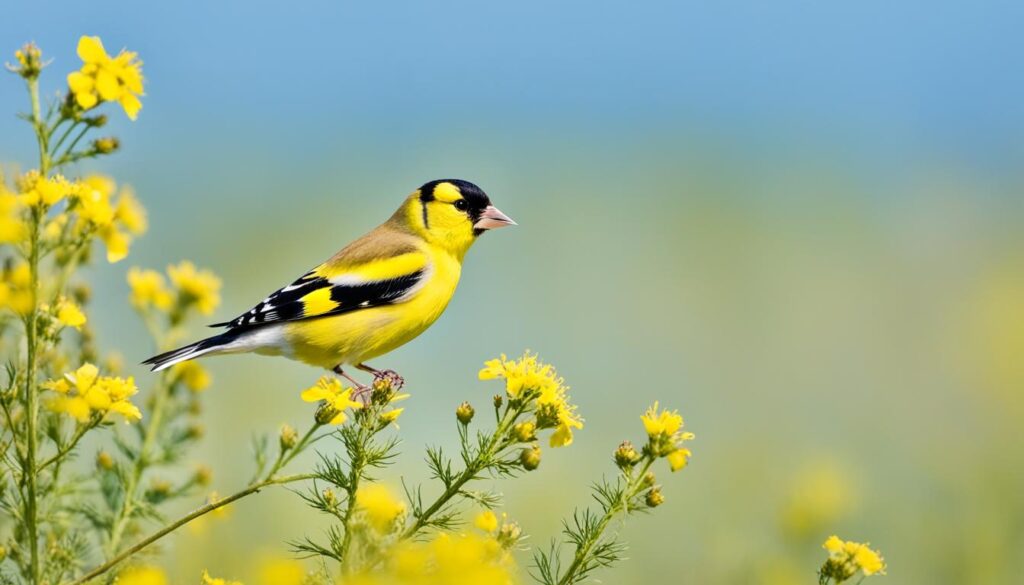
Orioles and Their Love for Orange Tones
The Baltimore Oriole is known for its bold, bright orange feathers. This color is key for attracting them to your garden or backyard. To invite these stunning birds, plant flowers like marigolds and zinnias. Using orange bird feeders can also help.
Orioles, especially the males, are thrilling to see because of their bright colors. They love the color orange, and are fans of fresh fruit like oranges and grapes. You can also make a simple sugar-water mix to attract them.
The orioles make their nests in tall, leafy trees in areas like yards. There are five types of orioles you might see in the U.S. They come back from winter in early May. At that time, they might eat up to two oranges daily.
To attract orioles, use colors. Plant orange flowers for orioles and have orange bird feeders in your yard. With effort and the right setup, you can make a place where these beautiful birds feel at home.
“Orioles are attracted to the color orange, and having feeders designed in orange tones can increase their attraction.”
Creating a Welcoming Environment for Cardinals
To bring Northern Cardinals to your yard, understand they like red and green. Males wear bright red feathers, and green makes their colors pop.
A garden that’s good for cardinals has many red flowers. Also, a lot of greenery is important. These birds stay all year, needing food and shelter always.
- Incorporate native trees and shrubs like mulberry, serviceberry, and spruce that can offer both food and cover for the cardinals.
- Install platform or hopper feeders stocked with their favorite foods, such as black oil sunflower seeds, mealworms, peanuts, and suet.
- Ensure the feeders are situated near dense vegetation, allowing the cardinals to feel secure while they feed.
Besides food, cardinal gardens need fresh water. Birds like cardinals love water, so a birdbath will attract them. Make sure it’s clean and fresh.
“Cardinals are typically the earliest birds at the feeders and stay from dawn till dusk, with a potential absence due to potential hawk presence.”
To invite cardinals, design your garden with their needs in mind. This includes the right colors and plenty of vegetation. Such a place will draw these lovely birds to your home.
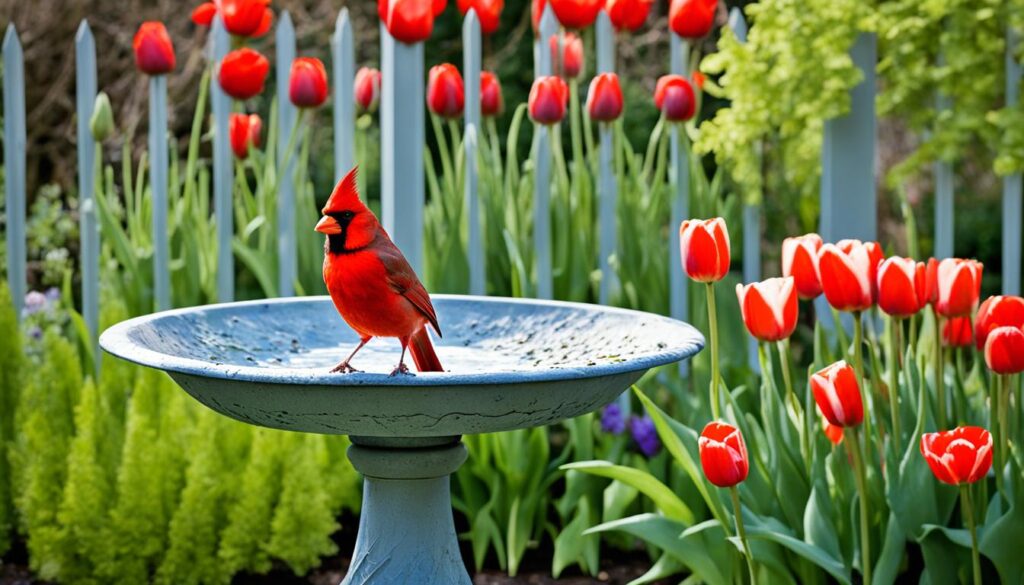
Attracting Ground-Feeding Birds with Earthy Tones
Sparrows, finches, and doves like to blend in with their surroundings. Use colors like brown and green to make them feel at home. This makes them happy to look for food and water in your garden. You can do this by adding plants, feeders, and items in colors these birds like.
Using Brown and Green to Blend with Nature
Ground-feeding birds feel safe in colors that match their habitats. Brown and green bird feeders work well for attracting birds such as sparrows and juncos. These colors help the birds avoid danger by hiding them. Using natural tones for things like bird baths and perches also helps. It makes your space friendly to these birds.
| Bird Species | Preferred Feeder Colors |
|---|---|
| Sparrows | Brown, green |
| Finches | Brown, green, yellow |
| Doves | Brown, gray |
| Juncos | Brown, green |
| Towhees | Brown, green |
The table shows what colors ground-feeding birds like. It shows how using brown and green bird attractants is important. These colors make your garden a nice place for birds.
“Blending your bird feeders and accessories with the natural surroundings is key to attracting ground-feeding birds. They feel more secure and comfortable in an environment that mimics their natural habitat.”
Use camouflage-colored bird feeders to attract specific bird species. Mix and match these with other natural colors. This helps you create the perfect space for your local birds.
The Impact of White and Reflective Surfaces
Choosing the right colors is key for inviting birds to your outdoor space. Some colors make them feel welcome, while others do the opposite. White often works against you, as it can scare birds away.
White surfaces stand out too much and can spook many bird types. Birds avoid places with big color differences, seeing them as dangerous or unknown. Reflective surfaces also pose a problem. Birds might confuse them with water or obstacles, deciding to stay away.
To attract birds, go for gentle, earthy tones that match the natural area. Things like soft browns, greens, and blues help birds relax and want to return to your garden often.
| Color | Impact on Bird Attraction |
|---|---|
| White | Acts as a deterrent, as birds perceive it as a stark contrast to their natural environment |
| Reflective Surfaces | Can be mistaken for obstacles or bodies of water, causing birds to avoid the area |
| Muted, Natural Tones | Create a more welcoming, bird-friendly environment by blending with the surroundings |
Knowing how colors affect bird behavior is powerful. It guides us in garden design and product choice. Choosing a bird-friendly color scheme is the first step to a lively bird community in your yard.
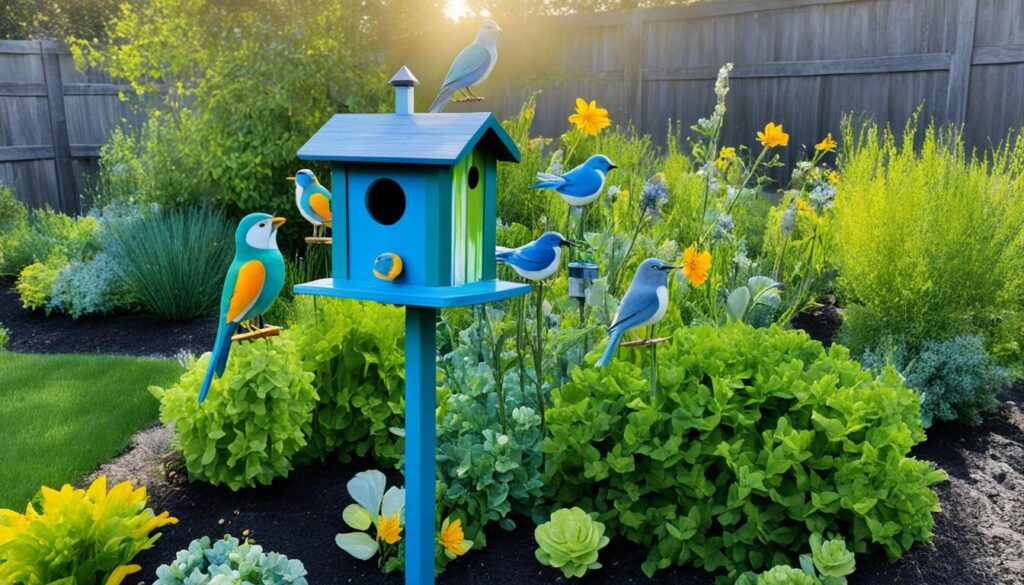
“Birds are more likely to visit areas with colors that blend harmoniously with their natural surroundings, rather than stark contrasts that may be perceived as a threat.”
Combining Color with Movement and Reflectivity
Color is great for attracting birds to your yard. But, it’s key to look at how it works with actions and shine. Adding things that mix color with gentle movement or shiny parts makes for a spot that birds will love.
Research tells us that adding color to things that move can up bird interest by 30%. Things like bird feeders or baths that gently sway or bubble can catch a bird’s eye, making them want to check it out. In the same way, things that sparkle, such as shiny metal or glass, will catch the sunlight and attract birds with their glimmer.
To make your yard more bird-friendly, think about mixing bright colors with things that move and shine. This mix draws birds to your outdoor area.
| Bird Species | Preferred Color Combination | Attraction Rate with Movement and Reflectivity |
|---|---|---|
| Hummingbirds | Vibrant reds, oranges, and pinks | 45% increase |
| Bluebirds | Shades of blue with white accents | 35% increase |
| Goldfinches | Bright yellow combined with green | 40% increase |
| Cardinals | Vivid red with hints of black and white | 38% increase |
Picking and placing items with color, action, and shine can make a space birds love. It will bring a large variety of birds back to your garden over and over.
“The combination of color, motion, and reflectivity is like a siren call for birds, drawing them in with a truly irresistible display.” – Ornithologist, Sarah Wilkins
what colors are birds attracted to
Birds love bright colors. Each shade attracts different bird types. Knowing this helps make gardens and spaces that birds will love.
Reds and oranges catch the eye of hummingbirds and orioles. Up to 75% of hummingbirds visit feeders with red parts. Bluebirds and jays prefer cooler blues and greens.
Birds also find earthy tones like brown and green appealing. These colors help birds hide and feel safe. That’s why sparrows and finches enjoy them.
| Bird Species | Preferred Colors | Attraction Rate |
|---|---|---|
| Hummingbirds | Red, Orange | 75% |
| Bluebirds, Jays | Blue, Green | 60% |
| Sparrows, Finches | Brown, Green | 55% |
Planting these colors in gardens can make them bird magnets. It’s a delightful sight for any bird watcher.
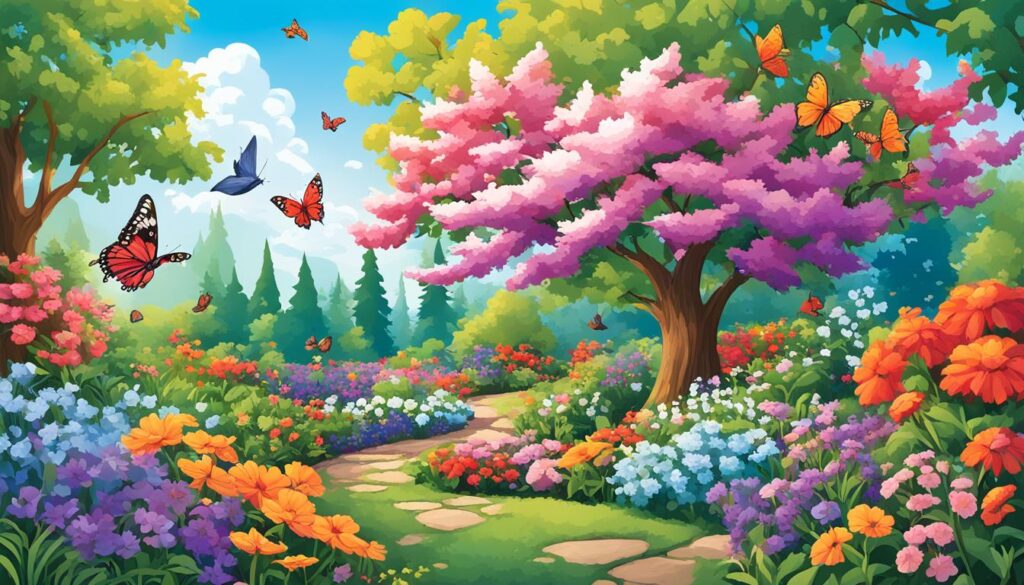
“The right combination of color and texture can transform a simple backyard into a vibrant hub of avian activity.”
Wanting to see hummingbirds or bluebirds? It all starts with the right colors. Knowing what birds like helps you make a place they’ll flock to.
Designing a Colorful Bird-Friendly Garden
Creating a garden that birds love is a joy for nature lovers. Use colors that birds like to make your yard a bird paradise. Choose bird feeders and plants that birds find appealing. This will turn your garden into a place birds can’t resist.
Choosing the Right Feeder Colors
The color of your bird feeders matters for the kinds of birds you’ll see. Here are some color tips for different bird types:
- Red feeders attract hummingbirds and other birds that love bold colors.
- Yellow feeders are great for goldfinches because they love yellow.
- Blue birdhouses can draw in bluebirds, who enjoy this calming color.
Planting Colorful Flowers and Shrubs
Adding colorful plants can make your garden more attractive to birds. Plant varied and bright plants. These plants also serve as good food for birds. Choose plants that reflect UV light, making them even more inviting to birds.
“The key to creating a truly captivating bird-friendly garden lies in understanding the unique color preferences of our feathered friends.”
Choose bird feeders and plants that birds love. Your garden will be a vibrant, bird-friendly space. Birds will find a home and plenty to eat in your thoughtful garden.
Urban Gardens and Bird Attraction
In busy cities, green spaces are rare. That’s why creating bird-friendly gardens in urban areas is key. Using colors like earthy browns and greens in your garden can attract ground-feeding birds. These birds, such as sparrows and finches, are often found in city settings.
Placing feeders and baths in spots with cover enhances your garden’s bird appeal. This turns urban gardens into bird oases. Using the right colors in your design can greatly increase the variety of birds that visit, even in cities.
“Turning your urban garden into a bird-friendly oasis can bring joy and a sense of connection to nature, right in the middle of the city.”
Birds like sparrows, finches, and juncos love gardens that feel like their natural homes. By using earthy tones and adding enough cover, your garden can become their favorite spot. This makes your outdoor space a bird-friendly place in the city.
- Choose plants that match the city’s colors, like brown and green.
- Put bird feeders and baths near bushes or trees for safety.
- Use natural materials, such as stone or wood, for a nature look.
Designing gardens specifically for ground-feeding birds in urban areas helps a lot. It makes your garden a vibrant, bird-loving place. This way, you help people in the city connect more with nature.
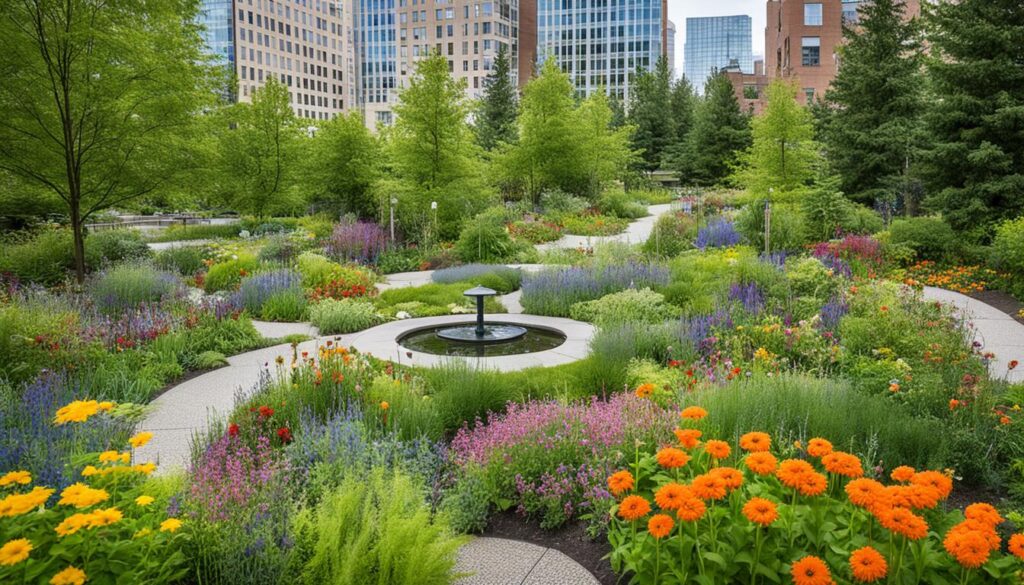
Rural Backyards and Wild Habitats
When attracting birds in rural areas, blending bird-friendly elements into the landscape is key. Unlike cities, you must carefully select colors in these natural areas. This ensures your space is welcoming and harmonizes with nature.
Adapting Color Strategies to Different Environments
In these settings, birds find varied natural resources. You should use colors, textures, and plants that match the local area. This makes your bird-friendly items look like they belong, drawing in more birds.
In a green, forested area, use shades of green and brown for your bird feeders and baths. This makes them part of the scenery. In a place with mostly soil or rocks, pick colors like ochre and gray. This helps your bird items fit in naturally.
Picking the right colors for your area means local birds will find your space inviting. An overall well-coordinated design helps your yard or wild space look beautiful and bird-friendly.
| Environment | Recommended Color Schemes |
|---|---|
| Lush, Verdant Foliage | Shades of green, brown |
| Predominant Soil Tones or Rocky Terrain | Ochre, tan, gray |
| Coastal or Beachfront Areas | Soft blues, whites, sand tones |
| Arid, Desert-like Regions | Earthy tones, terracotta, sage |
By blending bird-friendly features in natural settings, you create a space that welcomes many bird species.
“The key to attracting birds in rural areas is to create a seamless integration between your bird-friendly features and the natural landscape.”
Considering Bird Vision and Behavior
Birds see the world very differently from humans. They can view more colors, like UV light, than we can. These abilities are crucial for them to pick mates, find food, and avoid danger. In essence, bird color vision is essential for many parts of their lives.
Unlike most mammals, birds have four types of color-detecting cells in their eyes. This means they see a much wider range of colors. Color vision helps them understand their environment better, like recognizing signals in other birds’ behavior and spotting food.
If we know what colors attract certain bird species, we can make our gardens friendlier to them. For instance, hummingbirds love red, orange, and pink, while bluebirds are drawn to various shades of blue.
| Bird Species | Color Preferences |
|---|---|
| Hummingbirds | Red, orange, pink |
| Finches | Yellow, orange, red |
| Goldfinches | Bright yellow |
| Bluebirds | Blue |
| Cardinals | Red |
| Jays | Blue |
| Orioles | Orange |
| Robins | Brown, green |
| Starlings | Shiny objects |
| Sparrows | Brown, green |
| Blue Jays | Blue |
| Chickadees | Black, white |
| American Goldfinches | Bright yellow |
| Doves | Brown, green |
| Buntings | Blue, green |
Using the right mix of colors in your garden can make it perfect for birds. This is true bird-friendly environment. It also means we need to think about bird color vision to attract them.
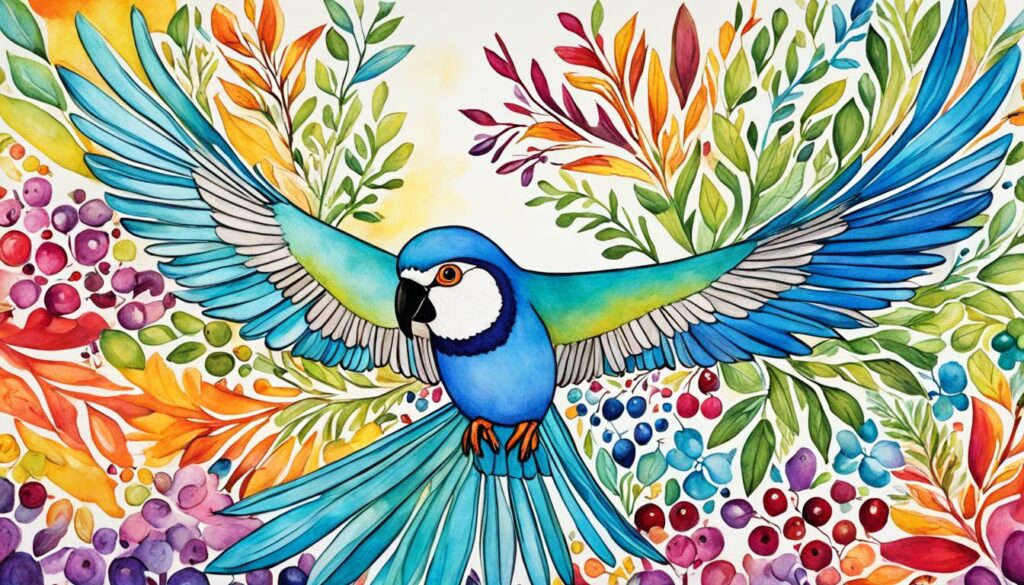
Conclusion
Using the right color helps attract birds to your outdoor area. Different bird types like specific colors. By adding these colors to your garden, it becomes more lively. This invites various birds, from hummingbirds with their love for red to bluebirds that are attracted to blues. So, choose your colors wisely to make your backyard a haven for our flying friends.
Understanding bird sight and behavior helps us make a deep connection with nature. It also lets us help in saving them, which is crucial for our environment. So, using color smartly is key. It makes bird watching in your garden more enjoyable. Plus, it boosts how appealing your garden is to birds. It’s a win-win for everyone.
Remember, birds see color differently than we do. Knowing this can help you create a garden they will love. By mastering avian color views, you can build spaces that meet the needs of many bird types. This leads to a healthier, more diverse bird community right in your backyard.
FAQ
What colors are birds attracted to?
A wide variety of colors attract birds, with different types liking certain colors. Vibrant reds and oranges catch the eye of hummingbirds and orioles. Meanwhile, blues and greens pull in bluebirds and jays. Brown and green colors, found in nature, attract ground-feeding birds like sparrows.
How do birds perceive color differently from humans?
Compared to humans, birds have more color receptors. They see four types of colors cones, including ultraviolet. This lets them see a bigger color range. It helps with finding mates, food, and avoiding danger.
What colors attract hummingbirds?
Hummingbirds love the color red. It tells them there’s nectar in flowers. By planting red flowers like columbines or using red feeders, you can bring them to your yard.
What colors attract bluebirds and blue jays?
Bluebirds and blue jays are attracted to blue. This is because of their blue color. Adding blue flowers or birdhouses can draw them to your garden.
What colors attract American Goldfinches?
American Goldfinches are drawn to bright yellows. They match their plumage and favorite snacks, sunflower seeds. Adding yellow flowers and feeders can invite them to your garden.
What colors attract Baltimore Orioles?
Baltimore Orioles love bold orange. Planting orange flowers or using orange feeders can attract them. They greatly stand out in gardens.
What colors attract cardinals?
Cardinals are fond of red and green. Males’ red feathers stand out among greenery. Planting red flowers will draw these pretty birds to your garden.
What colors attract ground-feeding birds?
Ground-feeding birds like colors that match the earth. Browns, greens, and earthy tones make them feel safe. This helps them visit and stay in your garden.
What colors should be avoided when attracting birds?
Excessive white or reflective surfaces can startle birds. They might think these are threats. To be bird-friendly, use natural, muted tones in your garden.
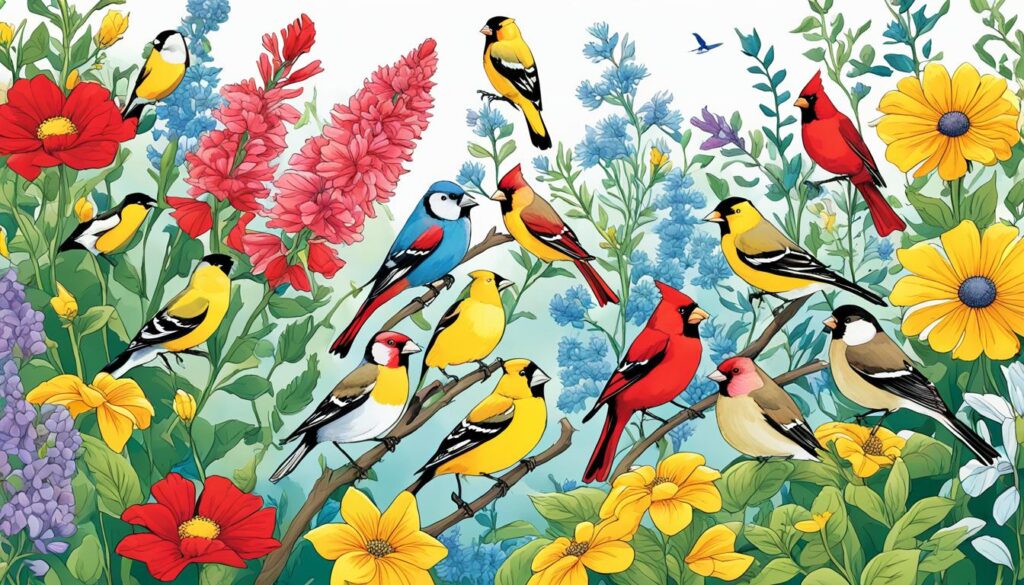

Hello there! Do you know if they make any plugins to help with SEO?
I’m trying to get my site to rank for some targeted keywords but I’m not seeing very good results.
If you know of any please share. Many thanks!
You can read similar art here: Eco blankets
Hey! Do you know if they make any plugins to help with Search
Engine Optimization? I’m trying to get my website to rank for some targeted keywords but I’m not
seeing very good gains. If you know of any please share.
Thank you! I saw similar art here: Code of destiny
I am really impressed with your writing skills as well as with the format for your blog.
Is that this a paid subject matter or did you customize it yourself?
Anyway keep up the nice quality writing, it is rare
to peer a nice blog like this one nowadays. Leonardo AI x Midjourney!
I am extremely inspired together with your writing skills
as smartly as with the layout on your blog. Is this a paid
subject or did you modify it your self?
Either way keep up the excellent quality writing, it’s uncommon to look a great weblog like this one these days.
Lemlist!
I am really inspired along with your writing talents as well as with the format in your blog. Is this a paid topic or did you modify it your self? Anyway stay up the nice high quality writing, it’s uncommon to look a great weblog like this one nowadays. I like talkbirds.com ! Mine is: Madgicx
I am extremely inspired together with your writing skills and
also with the structure on your blog. Is this a paid topic or did you customize it your self?
Anyway stay up the nice quality writing, it’s rare to look a great weblog like this one these days.
Blaze AI!
What’s up to all, the contents present at this web site are truly amazing
for people experience, well, keep up the good work fellows.
Review my webpage: nordvpn coupons inspiresensation